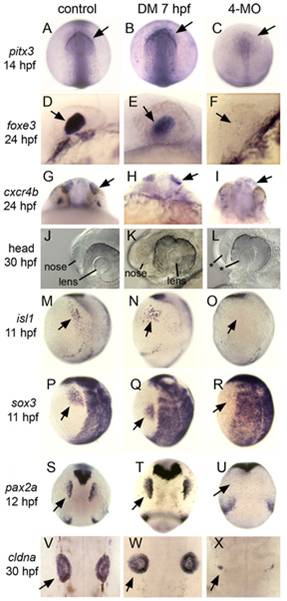Fig. 4
Fig. 4 Formation of cranial placodes requires competence factors but not Bmp during gastrulation.
Analysis of various cranial placode markers in control embryos, embryos treated with 100 ÁM DM at 7 hpf, or foxi1/gata3/tfap2a/c quadruple morphants (4-MO). Arrows indicate relevant expression domains in placodal tissues. (A?C) Dorsal views (anterior up) of pitx3 expression in anterior pituitary and lens placode. (D?F) Lateral views (anterior to left) of foxe3 expression in the lens placode. (G?I) Frontal views of cxcr4b expression in olfactory placode. (J?L) Lateral views (anterior to left) showing the lens and nasal pits in live specimens at 30 hpf. Asterisks in (L) depict the absence of morphologically discernable structures. (M?O) Lateral views (anterior up) of isl1 expression in the trigeminal placode. (P?R) Lateral views (anterior up) of sox3 expression in the epibranchial placode. (S?U) Dorsal views (anterior up) of pax2a expression in the otic placode. (V?X) Dorsal views (anterior up) of cldna expression in the otic vesicle. All placodal markers are expressed normally in DM-treated embryos. Expression of cldna is severely deficient in quadruple morphants (X, n = 13/21) or ablated altogether (8/21, not shown). All other placodal markers are ablated in quadruple morphants (n?10 for each marker).

